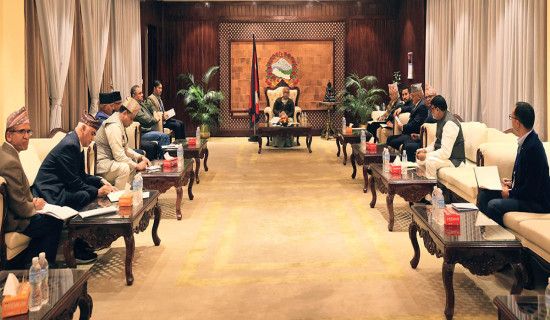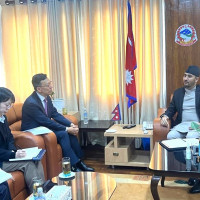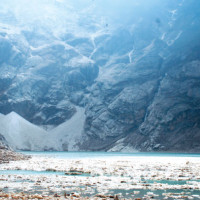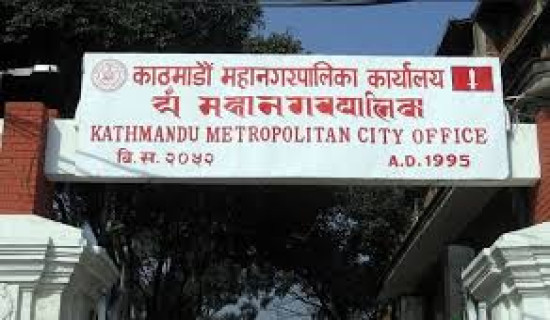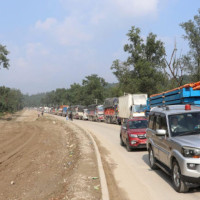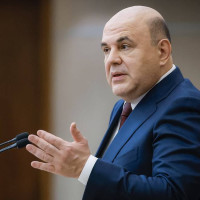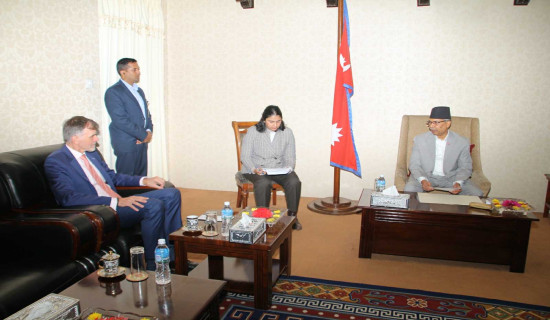- Monday, 3 November 2025
Govt prioritises large reservoir hydropower projects, targets to add 942 MW
By A Staff Reporter,Kathmandu, May 31: The government has allocated a budget of Rs. 86.1 billion for the Ministry of Energy, Water Resources and Irrigation for the fiscal year 2025/26.
Deputy Prime Minister and Finance Minister Bishnu Prasad Paudel in his budget speech prioritised energy production and export, expansion of irrigation infrastructure, and promotion of alternative energy.
DPM Paudel presented budget of Rs. 1,964.11 billion for the upcoming fiscal year at the joint session of the federal parliament on Thursday.
The government has set a target of generating additional 942 MW of electricity, with the country's total installed capacity at 4,800 MW.
In addition, 732 kilometers of double-circuit national transmission lines will be constructed.
The government has taken forward the plan to determine the investment framework and proceed with the construction process of large reservoir projects such as Dudhkoshi (670 MW), Lower Seti, Budhigandaki, Upper Arun, Tamor, Kimathanka and Arun for energy security.
In addition, the construction work of projects, including Tamakoshi-5, Chainpur Seti, and Jagdulla will also be accelerated.
The government's goal is to complete the detailed engineering design of the Karnali Chisapani Multipurpose Project and finalise the investment framework.
The projects with high potential for returns will be constructed under the People's Hydropower Programme in the management of the Nepal Electricity Authority (NEA) and with the co-investment of interested Nepali citizens.
Similarly, the government has planned to take the initiative to complete the DPR of the Pancheshwor Multipurpose Project and proceed with the construction work.
The government has unveiled plans to optimise the use, conservation, and regulation of water resources in accordance with the River Basin Master Plan, and to measure and digitise water levels for the use and management of groundwater resources.
The budget has aimed to encourage private sector investment in hydropower surveying, production, transmission, and distribution.
Domestic energy consumption will be increased by ensuring reliable electricity supply, and the remaining rural electrification work will be completed within the next two years, DPM Paudel said while reading out the budget.
The government has also planned to study the feasibility of green hydrogen in collaboration with universities and the private sector and attract domestic and foreign private investment to produce green hydrogen.
If solar and wind energy is stored in batteries and connected to the national system, arrangements will be made to enter into power purchase agreements similar to reservoir projects, he said.
Diplomatic initiatives will be taken with neighbouring countries to ensure electricity export and the transmission line projects such as new Butwal-Gorakhpur, Inaruwa-Purnia, Chameliya-Jaulbibi and others will be taken forward.
The government has made arrangements to allow industries to charge wheeling charge if they construct the distribution line from the national transmission system to the industrial site themselves, and will accelerate the work of undergrounding electricity distribution lines in dense urban areas.
Based on the potential for energy export, additional inland transmission lines will be constructed.
The government has allocated Rs. 13.18 billion for transmission line expansion and distribution projects.
The government has allocated Rs. 2.33 billion to promote alternative energy (solar, bio, wind), Rs. 8.5 billion for expansion of irrigation infrastructure, and Rs. 5.59 billion for water-borne disaster management.
In addition, a complete wiring project with electric stoves will be launched in major cities of all seven provinces, and the reconstruction of earthquake or flood-affected irrigation structures will also be carried out rapidly.
Irrigation facilities in 14,000 hectares of land
Irrigation infrastructure will be developed to expand the irrigated area in arable land.
The government plans to construct the headworks, canal, tunnel, powerhouse and distribution system of the multipurpose project in a manner so that they will be completed simultaneously.
Babai, Rani Jamara Kulariya, Mahakali, Praganna-Badkapath irrigation projects will be completed within the next three years.
The budget has proposed to accelerate the construction of Sikta and Mega Dang Valley Irrigation Projects.
The government has allocated Rs. 2.7 billion to complete the headworks and powerhouse construction of the Bheri-Babai Diversion Project within two years.
The government, which aims to achieve significant achievements in the irrigation sector, will provide irrigation facilities to 14,000 hectares of land, construct 63 kilometers of embankments, and protect 270 hectares of land from river erosion.
Likewise, lift irrigation facilities will be provided to 468,000 hectares of land within five years.
Under-construction projects will be completed to provide groundwater irrigation facilities in the Tarai and inner Madhes and Rs. 3.31 billion has been allocated for this.



